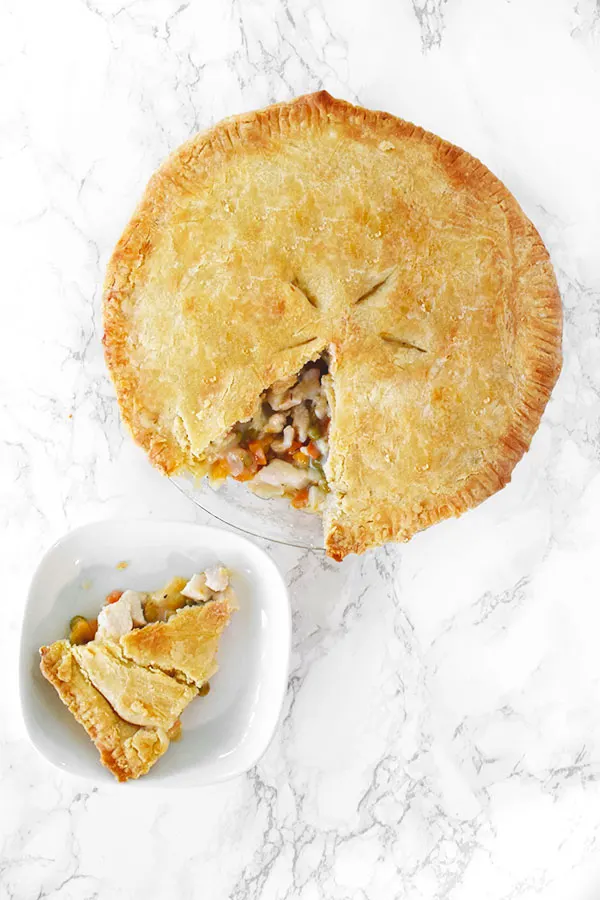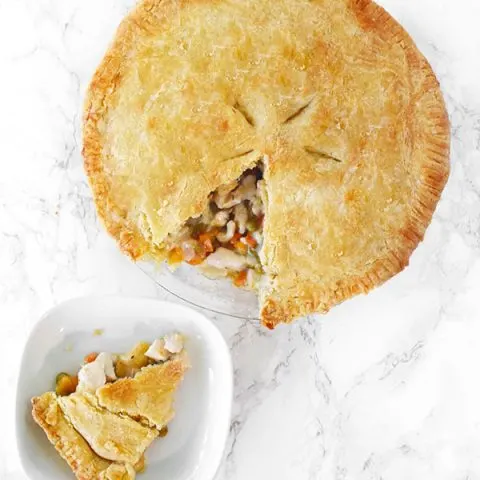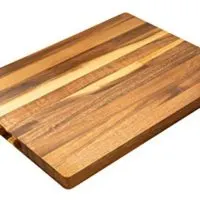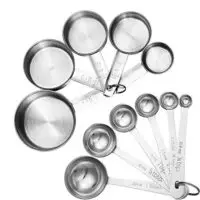If you love chicken pot pie, then you will love this dairy free turkey pot pie! It is an especially tasty way to use up leftover turkey from Thanksgiving.

I love everything about Thanksgiving, from the autumn foliage to the holiday spread. I look forward to it year-round and start planning for it shortly after the 4th of July.
However, as soon as Thanksgiving is over, I find myself with leftovers I have to find creative ways to repurpose. In my family, food going to waste is a grave sin.
This dairy free turkey pot pie is one of my favorite ways to give new life to leftover turkey!
History of Pot Pie
Pot pie is believed to have originated in ancient Greece. The Greeks cooked meats mixed with other ingredients in open pastry shells called Artocreas.
Later, the Romans supposedly took this recipe and added a top to the pastry crust, making it a fully enclosed meat pie like we serve today. These pies were served at banquets.
Then, during the Renaissance, the English gentry revived not only classical art, but the ancient meat pie. Meat pies became very popular, and pies made with pork, lamb, venison, and poultry were common.
In fact, they were so common, that a nursery rhyme incorporates it.
Sing a song of sixpence,
A pocket full of rye.
Four and twenty blackbirds,
Baked in a pie.
When the pie was opened
The birds began to sing;
Wasn't that a dainty dish,
To set before the king.
Notice how the pie was set before the king. This isn’t just being playful. Pot pies were considered a delicacy.
Pot pies were served at the wedding of Marie de' Medici and Henry IV of France.
However, the pies served were actually a form of amusement because when their guests sat to eat, songbirds flew out just like in the rhyme.
For at least a couple hundreds of years, this was a popular form of entertainment adopted from the ancient Romans. Cookbooks even had recipes on how to do this.
Eventually, pot pie became accessible to the commoner.
There is one pot pie named “Sea Pie” because it was made aboard ships where they used whatever meat they had available. It typically included pigeons, turkey, veal, and mutton.
Pot pie eventually made its way to America with settlers who brought their recipes with them and it spread as they moved west.
Then, within the last century, chicken became the most popular meat used in the States, making chicken pot pie a widely popular American dish.
In recent decades, turkey pot pie became a popular dish to repurpose Thanksgiving leftovers.
STOCK VS. BROTH
Broth is usually thinner and made from meat, while stock is made from simmering bones for a long time.
Stock is usually thicker and has a richer mouth feel from the gelatin releases from the long-simmered bones.
Adding onions, carrots, celery, bay leaves, and other herbs add to the flavor of the stock.
WHAT ABOUT STORE-BOUGHT STOCKS AND BROTHS?
Commercial brands tend to use the terms “stock” and “broth” interchangeably, and store-bought stocks and broths are usually more both then stock.
They tend to be lightly flavored, lack the body of a homemade stock, and they result in a less flavorful dish.
HOW STOCKS AND BROTHS ARE MADE
Broths and stocks are also made differently.
Stocks are typically made from meaty raw bones, leftover carcasses, and meat and vegetable scraps. In the case of vegetable stock, only vegetables are used.
Stocks are simmered for several hours (unless you make pressure cooker stocks) to extract as much of the flavor from the ingredients as possible. This also extracts collagen from the bones and cartilage, which adds body and silkiness to the stock.
Broths are usually much lighter and have less body than stocks.
They’re most often made from poaching meat, vegetables, and seasonings in water for as long as it takes for the meat to cook or the broth to pick up some flavor.
HOW STOCKS AND BROTHS ARE USED
In classic French cuisine, stocks are considered to be an ingredient that’s used to make other things.
Also, they’re typically left unseasoned or only minimally seasoned so that they can be used in as wide a variety of ways as possible.
Stocks can be used to make soup, reduced into a sauce or a glaze, or as an ingredient in many recipes.
Broths, on the other hand, have been salted, which restricts the ways they can be used.
For the most part, broths are consumed on its own or used as a base for soups like chicken soup.
This definition of stocks as an ingredient and broths as a food product is the way classically trained chefs tend to think about such things in their restaurant kitchens.
What's the difference between a pot pie and a regular pie?
A pot pie is a savory dish with meats, vegetables, and a creamy sauce. A regular pie, on the other hand, is often sweet and is filled with fillings such as fruit, custard, or chocolate.
Is turkey pot pie dairy?
Yes, turkey pot pie contains dairy because it is typically made with milk or heavy cream and both the filling and crust contain butter. This recipe uses dairy free milk and oil.
Which dairy free milk should I use?
Honestly, it's whatever you have on hand or prefer.
My go-to is a neutral flavored full fat oat milk because I find that they are the most similar to regular full fat milk.
Almond milk works well here, too. I personally like using an unsweetened barista almond milk because it is more similar to regular full fat milk, but whatever you have will work.
You can also use coconut milk, though it may have a subtle coconut flavor if you do. Coconut milk has more fat and is similar to using a light cream, but it won't make a noticeable difference.
I've never used soy milk, so I don't have any opinions on it, but you can use that as well.
IS KOSHER TURKEY BETTER?
Kosher animals are kept in better conditions than non-kosher animals due to strict kosher health requirements of the animals.
Also, the salting process used as part of the process of making meat kosher is similar to dry brining, and therefore produces a better quality meat.
While I’ve only eaten kosher meat so I cannot compare, I’ve been told by non-Jews who do not keep kosher that they’ve noticed that kosher turkey is of superior quality to cook with.
SHOULD YOU WASH TURKEY?
According to the USDA, you should not wash meat or poultry, since water can splash bacteria up to 3 feet surrounding your sink.
A study done by Drexel University shows that it is best to move meat and poultry directly from package to pan. The heat from cooking will get rid of any bacteria that may be present.
HOW CAN I CLEAN MY TURKEY WITHOUT WASHING IT?
If you want to clean your turkey without washing it, wipe it down with a wet paper towel.
Just make sure the paper towel doesn't touch anything else and to toss the paper towel right away.
HOW TO DEFROST TURKEY
IN THE FRIDGE
Defrosting turkey in the fridge is the most highly recommended.
To do this, place the frozen turkey in a pan and let it thaw. Oftentimes, when turkey thaws, it releases liquids that can leak onto your fridge, so the pan is really helpful.
Turkey typically takes a full day to thaw. Once thawed, it can remain in the refrigerator for a day or two before cooking.
IN COLD WATER
Defrosting turkey in water should take two to three hours.
Submerge your sealed turkey in a pot or bowl full of cold water. Change out the water every 30 minutes or so.
Do not hot use water because it can start cooking your turkey.
Can you cook FROZEN turkey?
According to the USDA, you can cook frozen turkey. It will take 50% longer to cook, but it’s an option.
You should also cook it on a roasting rack or over vegetables so that the heat can circulate around the turkey.
CAN YOU REFREEZE RAW TURKEY?
According to the USDA, “food thawed in the refrigerator is safe to refreeze without cooking.” However, you do lose quality when refreezing previously defrosted meat.
Every time you defrost meat, it loses moisture as it thaws, which also leads to a loss in flavor. To compensate for this, marinate the turkey to add more flavor and juice.
The USDA also says not to “refreeze any foods left outside the refrigerator longer than 2 hours; 1 hour in temperatures above 90°F.”
SHOULD YOU BRINE?
Brining actually doesn’t do anything to help poultry. In fact, it makes it soggy rather than juicy, with watered-down flavor.
Aromatic brines and stock don’t help with flavor either. This is because the salt pulls water molecules in, leaving most of the flavor behind.
DRY BRINING
A dry brine, on the other hand, loosens up muscle fibers, allowing them to retain more moisture without adding any excess liquid.
Initially, the salt draws moisture out, then it dissolves in this liquid, creating a concentrated brine, which eventually gets reabsorbed. This leads to more intensely flavored results.
An added benefit is that it also requires less space and mess than a water brine. Not to mention the fact that it allows for crispier skin.
CAN YOU DRY BRINE KOSHER turkey?
Food experts are often under the impression that kosher meat and poultry cannot be brined and dry brined.
This is because of the koshering process, which involves salting the meat. However, the process is not nearly as long as the dry brining process, and unlike a dry brine, the poultry is soaked to remove the salt.
So, since the process is different than a dry brine, it is fine and even recommended to dry brine kosher poultry and meat.
How do you dry brine turkey?
Begin by patting the turkey with paper towels. This will help the salt adhere to the turkey.
Grab pinches of kosher salt and sprinkle it over the turkey until the turkey is generously salted and evenly coated.
Place the dry-brined turkey on a rack or a plate and refrigerate it. Refrigerate turkey pieces for at least 1 hour, skinless pieces for 30 minutes to 1 hour or up to about 12 hours, and a whole turkey for 8-24 hours.
Once the waiting period is up, there is no need to rinse off the turkey. Just cook it as usual.
Adjusting for a Convection Oven
Convection ovens blow the hot air around, producing around 25 to 30 percent more heat.
Since convection ovens produce more heat, you need either lowering the temperature or shortening the cooking time to compensate.
When recipes specify temperatures and cooking times, it’s for conventional ovens, unless specified otherwise.
A simple rule to follow is to lower the temperature by 25ºF or 14ºC when baking cookies and pies, and 50ºF or 28ºC when roasting meat and poultry. Some convection ovens offer separate settings for baking and for roasting.
You can also leave the temperature the same and instead, shorten the cooking time by 25 percent. For example, if your recipe calls for 60 minutes in the oven, check the food after 45 minutes instead.
However, keep in mind, some convection ovens actually make a heat adjustment for you. That is, if you set a convection oven for 350ºF, it might actually set itself to 325ºF to compensate. So, check your manual before making adjustments.
HOW TO STORE TURKEY
Place cooled turkey in an airtight container or wrap in heavy-duty aluminum foil or plastic wrap. Store in the fridge for up to 4 days.
HOW TO FREEZE TURKEY
Freeze leftovers within 3-4 days. Place cooled turkey in an airtight container or resealable freezer bag.
Freeze for up to 4-6 months. After that, it is still safe to eat, but the quality begins to degrade.
Dairy Free Turkey Pot Pie

This dairy free turkey pot pie recipe is made without milk and without cream. It is a simple, easy, and one pot recipe. It can also be easily modified to taste by adding potatoes, celery, and removing carrots.
Ingredients
- 3 tablespoons oil
- 3 cloves of garlic, died, optional
- 2 medium carrots, diced
- 1 small onion, diced
- 1 celery stalk, diced (optional)
- 1 cup frozen green peas
- ⅓ cup all-purpose flour
- 1 ¾ cups chicken stock
- ½ cup dairy free milk*
- 2 cups leftover turkey, cubed, or shredded
- 1 double 9-inch pie crust
- 1 egg, beaten
Instructions
- Preheat oven to 425°F or 220°C.
- In a saucepan, heat the oil. Then, when hot, lower to a medium heat and add garlic, onions, carrots, celery if desired, and peas. Cook until the onions are translucent and/or the carrots are tender.
- Stir in flour and mix until it coats all the vegetables and mix for a few minutes.
- Slowly stir in chicken stock a little at a time to avoid clumping. Once it's smooth, finish pouring in the stock and add the dairy free milk.
- Add the turkey pieces. Simmer over medium-low heat until thick like gravy. Add salt to taste.
- Line the bottom of the pie pan with the pie crust. Pour the hot liquid mixture over it.
- Cover with top crust, seal edges, and cut away excess dough. Brush egg and make several small slits in the top to allow steam to escape.
- Bake for 30 to 35 minutes or until crust is golden brown. Remove from oven and let cool for 10 minutes before serving.
Notes
If you want to make this pot pie a little more gourmet, you can add one cup of dry white wine when making the sauce and ½ teaspoon dried thyme when simmering.
If using a deep dish pan, double the liquid for the sauce.
Recommended Products
Some of the links below are affiliate links, which means that if you choose to make a purchase, I will earn a small commission. This commission comes at no additional cost to you.
-
 Pyrex Easy Grab Glass 9.5 Inch Pie Plate (2-Pack)
Pyrex Easy Grab Glass 9.5 Inch Pie Plate (2-Pack) -
 Mrs. Anderson’s Baking Pie Crust Protector Shield
Mrs. Anderson’s Baking Pie Crust Protector Shield -
 Villa Acacia Solid Wood Cutting Board, 17 x 12 Inches
Villa Acacia Solid Wood Cutting Board, 17 x 12 Inches -
 Victorinox 8-Inch Chef's Knife
Victorinox 8-Inch Chef's Knife -
 OXO 1058020 Wooden Turner for Nonstick Cookware, 1 Count, Beech
OXO 1058020 Wooden Turner for Nonstick Cookware, 1 Count, Beech -
 Accmor Stainless Steel Measuring Spoons and Cups Set
Accmor Stainless Steel Measuring Spoons and Cups Set
Nutrition Information:
Yield:
8Serving Size:
1Amount Per Serving: Calories: 290Total Fat: 15gSaturated Fat: 3gTrans Fat: 0gUnsaturated Fat: 11gCholesterol: 63mgSodium: 230mgCarbohydrates: 23gFiber: 3gSugar: 4gProtein: 15g